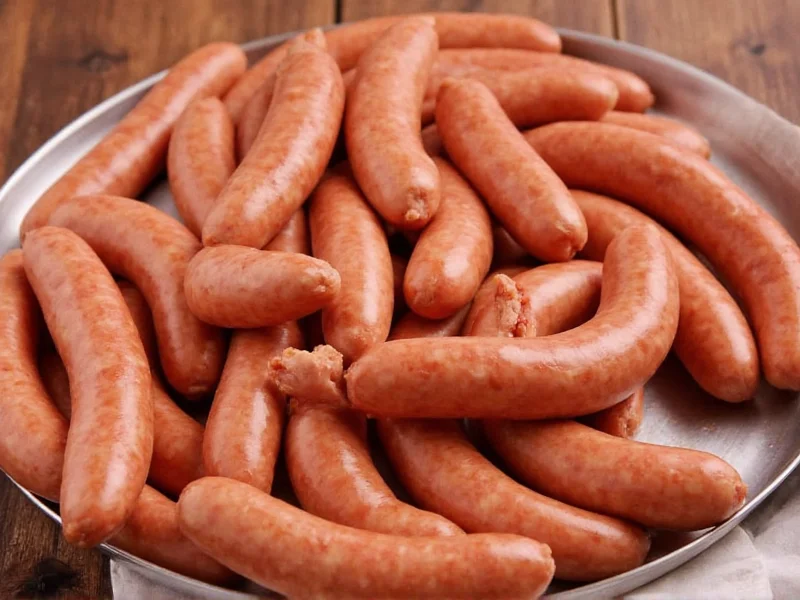When exploring sausage preparation methods, encountering unfamiliar terminology can create confusion for both home cooks and culinary professionals. The phrase \"sausage fattener\" frequently appears in search queries but represents a common misconception in sausage-making vocabulary. Understanding the correct terminology is essential for anyone pursuing authentic sausage preparation techniques.
Decoding Sausage Terminology Misconceptions
The confusion around \"sausage fattener\" typically originates from translation errors between languages or misinterpretations of sausage production processes. In reality, professional butchers and charcuterie experts use precise terminology that doesn't include this phrase. When examining sausage preparation literature from culinary institutions like the Culinary Institute of America or European charcuterie manuals, you'll find references to \"stuffers,\" \"fillers,\" and \"casings\"—never \"fatteners.\"
Essential Sausage Making Equipment Explained
What many searchers mean when they query \"sausage fattener\" is actually sausage stuffing equipment. Proper sausage production requires specific tools designed for filling casings with meat mixtures. Let's clarify the correct terminology:
| Correct Term | Purpose | Common Misconceptions |
|---|---|---|
| Sausage stuffer | Mechanical device for filling casings with meat mixture | Often mistakenly called \"sausage fattener\" or \"sausage filler machine\" |
| Sausage filler | Refers to the meat mixture itself before casing | Sometimes confused with equipment rather than ingredient |
| Sausage casing | Natural or synthetic tube that contains the meat mixture | Rarely called \"sausage skin fattener\" in error |
How Sausage Stuffing Actually Works
Professional sausage production relies on precise stuffing techniques rather than any \"fattening\" process. The sausage stuffer—available in manual crank, electric, and hydraulic models—applies consistent pressure to fill casings without creating air pockets or uneven distribution. Proper stuffing density directly impacts cooking results and texture. Under-stuffed sausages develop wrinkles and cook unevenly, while over-stuffed varieties risk bursting during cooking.
When selecting sausage making equipment for home use, understanding these distinctions proves crucial. Quality sausage stuffers from reputable manufacturers like Weston, LEM Products, or manual models from Italian charcuterie specialists enable precise control over filling density. The goal isn't to \"fatten\" the sausage but to achieve optimal filling that maintains structural integrity during cooking.
Common Sausage Preparation Mistakes to Avoid
Many amateur sausage makers encounter problems stemming from terminology confusion. They might search for non-existent \"sausage fattener products\" rather than learning proper stuffing techniques. Common issues include:
- Using inappropriate fillers that compromise texture
- Applying incorrect pressure during stuffing
- Misunderstanding the relationship between meat temperature and stuffing consistency
- Confusing sausage extenders (used in commercial production) with \"fatteners\"
Professional charcutiers emphasize that sausage quality depends on proper meat-to-fat ratios (typically 70-80% lean meat to 20-30% fat), seasoning balance, and correct stuffing technique—not any mythical \"fattening\" process. The texture and cooking behavior of sausages derive from these fundamental elements rather than post-production \"fattening\" methods.
Authentic Sausage Making Resources
For those serious about sausage preparation, consulting authoritative resources proves far more valuable than searching for non-existent \"sausage fattener\" products. Recommended references include:
- \"Charcuterie: The Craft of Salting, Smoking and Curing\" by Michael Ruhlman and Brian Polcyn
- European Union guidelines on traditional sausage production methods
- Certified Master Butcher training materials from professional culinary organizations
- University agricultural extension programs specializing in meat science
These sources provide scientifically validated information about sausage production without relying on misleading terminology. Understanding the precise language of charcuterie helps avoid common pitfalls and produces superior results.
Conclusion: Focusing on Proven Sausage Techniques
The search for \"sausage fattener\" reflects a common terminology gap in culinary knowledge rather than a legitimate sausage-making technique. By focusing on proper sausage stuffing equipment, understanding meat-to-fat ratios, and learning authentic preparation methods, both home cooks and professionals can create high-quality sausages without relying on non-existent \"fattening\" products. The path to exceptional sausages lies in mastering traditional techniques rather than searching for quick fixes or misunderstood terminology.
Frequently Asked Questions
What is the correct term for equipment that fills sausage casings?
The proper term is \"sausage stuffer\" or \"sausage filler machine.\" This equipment comes in manual crank, electric, and hydraulic varieties designed to fill casings with consistent pressure. The phrase \"sausage fattener\" doesn't refer to any legitimate sausage-making equipment.
Why do some people search for \"sausage fattener\" products?
This typically results from translation errors between languages or misunderstandings of sausage production terminology. Some non-English culinary terms might translate literally to \"fattener,\" but in professional charcuterie, we refer to \"stuffers\" for equipment and proper meat-to-fat ratios for ingredient composition.
Does anything actually make sausages \"fatter\" during production?
No legitimate sausage production process uses a \"fattening\" step. Sausage diameter depends on casing size and proper stuffing technique. Some commercial producers use extenders like breadcrumbs or starches, but these affect texture rather than size, and professional charcutiers avoid them in traditional recipes.
What's the ideal meat-to-fat ratio for homemade sausages?
Most traditional sausage recipes maintain a 70-80% lean meat to 20-30% fat ratio. This balance ensures proper texture, moisture retention, and flavor development during cooking. The fat content melts during cooking, basting the meat internally—this is why proper ratios matter more than any mythical \"fattening\" process.











 浙公网安备
33010002000092号
浙公网安备
33010002000092号 浙B2-20120091-4
浙B2-20120091-4